Gothic Quarter Barcelona
Sightseeing tour of Barcelona's Gothic Quarter.
Dive into the heart of Barcelona’s history with this tour of the Barri Gòtic, the Gothic Quarter — a true medieval labyrinth where every alley tells a story. With its picturesque squares, memory-laden monuments, and captivating atmosphere, this walk will help you discover the soul of the city.
How to Get to the Gothic Quarter
Address: The “Barrio Gótico” in Spanish or “Barri Gòtic” in Catalan is located in the heart of Barcelona. It is one of the four districts of the “Ciutat Vella”, the Old Town. “El Gòtic”, as locals call it, is bordered by Las Ramblas, Via Laietana, Passeig de Colom along the seafront, and Plaça de Catalunya on its southwestern edge. Numerous bus and metro lines converge on this central district.
Metro: 8 metro stations serve the Gothic Quarter
L1: Catalunya and Urquinaona stations
L2: Passeig de Gràcia station
L3: Liceu, Catalunya, and Drassanes stations
L4: Jaume I and Urquinaona stations
Where is Barcelona's Gothic Quarter?
The Barri Gòtic: From Past to Present
The Gothic Quarter was built on the remains of the Roman colony of Barcino, and features many Gothic buildings from the medieval period and neo-Gothic structures, a testament to its long restoration. This historical center of the city is a true labyrinth... Around the Cathedral, you can get lost — quite easily — in the narrow streets to discover the oldest monuments, churches, and ruins, as well as old and brand-new shops and boutiques. It was here, just steps away, that the most pivotal events in Barcelona’s history unfolded.
This district still holds great administrative importance for the city, as it houses not only the “Palau de la Generalitat”, the seat of the Catalan government, but also the “Casa de la Ciutat or Ajuntament”, Barcelona’s City Hall. These two buildings face each other on Sant Jaume Square. Another historic site is the “Palau Reial Major”, former residence of the Counts of Barcelona, and later of the Kings of the Crown of Aragon. According to popular legend, it was in this palace that Christopher Columbus was received by the Catholic Monarchs, Ferdinand II of Aragon and Isabella I of Castile, upon his return from the Americas in 1493. It is said Columbus presented his discoveries and treasures to the Spanish monarchs there. Such legends add to the charm of this district, which we invite you to explore.
Tour of the Gothic Quarter
Here’s a small selection of places to discover in the Barrio Gótico.
>>> We recommend the best hotels in the Gothic Quarter, an ideal place to stay in the Catalan capital.
Starting Point of the Tour
Our visit begins at Plaça de Catalunya, the nerve center of Barcelona, a meeting point between the old town and the modern neighborhoods. From there, we’ll take shopping streets and the charming alleys of the Gothic Quarter to reach our first must-see stop: the Barcelona Cathedral.
Barcelona Cathedral - Catedral de la Santa Creu ***

View of Barcelona Cathedral ( Holy Cross ) from the Avenue de La Cathédrale with La Placita de la Seu ( Cathedral in Catalan ) just in front.
The Cathedral of the Holy Cross, also known as the Cathedral of the Holy Cross and Saint Eulalia, is a Catholic church located in Barcelona’s Gothic Quarter. It was built from the 13th century on the ruins of an old Romanesque church. The Barcelona Cathedral features impressive Gothic architecture, with ribbed vaults, arcades, and chapels adorned with sculptures and paintings. It also houses many treasures, including paintings, sculptures, and ancient manuscripts.
Pla de la Seu, 3, 08002 Barcelona, Spain
Opening hours: Weekdays: 9:30 AM to 6:30 PM (last entry at 5:45 PM). Saturdays: 9:30 AM to 5:15 PM (last entry at 4:30 PM). Sundays: 2:00 PM to 5:00 PM (last entry at 4:30 PM).
Barcelona History Museum (MUHBA)
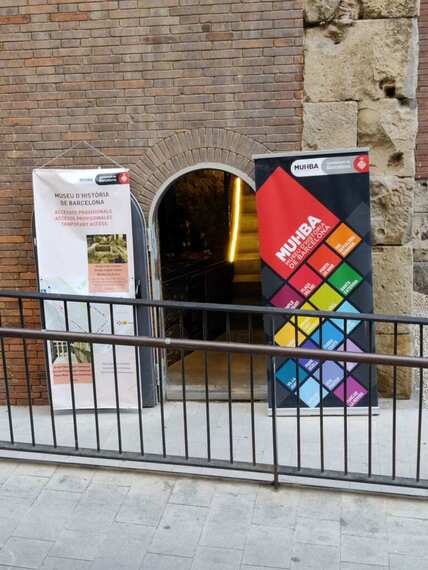
The side entrance to MUHBA: Barcelona History Museum
The Barcelona History Museum (MUHBA) offers a fascinating journey through over 2,000 years of the city's history, with Roman remains, medieval sites, and interactive exhibitions spread across several iconic locations in the Catalan capital. One of the main highlights is undoubtedly the archaeological site beneath the Plaça del Rei, where you can explore the ruins of ancient Barcino, the Roman city on which modern Barcelona was built. You’ll be able to walk through ruins of houses, paved streets, public baths, and dye workshops dating back to the 1st century BC.
Address: Plaça del Rei, s/n, 08002 Barcelona, Spain
Plaça del Rei, Tinell Hall and Chapel of Santa Àgata
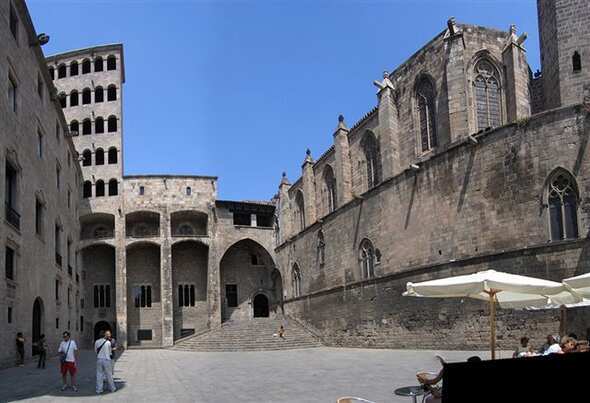
Plaça del Rei is Barcelona's elegant medieval square, the heart of Catalan royal power in the Middle Ages.
This is the most visited medieval complex in the city. Climb the palace steps to reach the Tinell Hall, a splendid 14th-century throne room. It was in this hall that the Catholic Monarchs, visiting Barcelona, received Christopher Columbus upon his return from the New World in 1493. The Chapel of Santa Àgata is decorated with the prestigious Constable's Altarpiece by Jaume Huguet.
Plaça del Rei, 08002 Barcelona, Spain
Opening hours: Chapel: Tuesday–Saturday from 10 AM to 2 PM and from 4 PM to 8 PM.
Frederic Marès Museum

The Frederic Marès Museum houses the founder's vast and eclectic collection of medieval sculptures and everyday objects.
Frederic Marès, the museum’s founder, was a sculptor, historian, and professor. His eclectic collection includes the most important ensemble of Hispanic sculptures from the 12th to the 19th centuries.
The Frederic Marès Museum, located in the Gothic Quarter of Barcelona, is a treasure trove for art and history lovers. Founded by sculptor and collector Frederic Marès in 1946, the museum houses an impressive collection of sculptures — particularly medieval ones — and numerous artworks that recount centuries of European history.
Address: Plaça de Sant Iu, 5, 08002 Barcelona
Carrer del Bisbe and the Pont del Bisbe

Neo-Gothic bridge by Joan Rubió in Barcelona, linking the Palau de la Generalitat to the Casa dels Canonges.
Carrer del Bisbe is one of the most iconic streets in Barcelona’s Gothic Quarter. Lined with historic buildings and medieval arcades, it connects Plaça Sant Jaume to Barcelona Cathedral. Its captivating atmosphere immerses visitors in the past, with decorated façades and the typical charm of Barcelona’s narrow streets.
The gem of Carrer del Bisbe is undoubtedly the Pont del Bisbe, a neo-Gothic footbridge built in 1928 by architect Joan Rubió i Bellver. This bridge, which connects the Palau de la Generalitat with the Casa dels Canonges, has become a symbol of the Gothic Quarter. Its elegant architecture, detailed carvings, and intricate stonework make it a must-see for history and photography lovers.
Look up to spot the mysterious carved skull beneath the bridge, the source of many local legends. A stop here offers one of the most beautiful views of old Barcelona, where history and timeless charm meet.
Plaça Sant Jaume
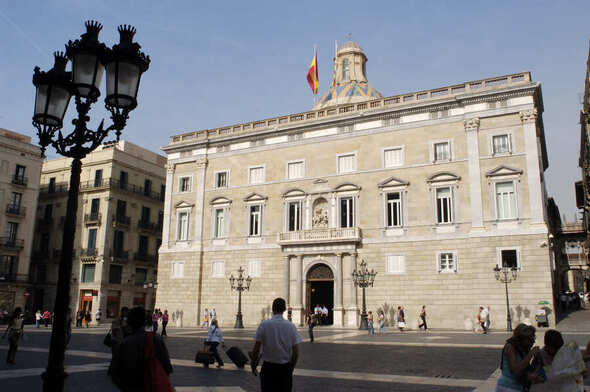
Plaça Sant Jaume is Barcelona's historic political center, where the Town Hall and the Palau de la Generalitat face each other.
Plaça Sant Jaume in Catalan (pronounced “Jaouma”: James) was the public square in ancient times — the forum. Today, it’s the institutional center of the city. Here, you'll find the City Hall ("Ajuntament") and the Palau de la Generalitat facing each other. This square is always lively, especially on weekends with traditional folk dances and castells (human towers). On Thursday evenings, the Barcelona Symphony performs concerts. On April 23rd, during the local version of Valentine's Day, Dia de Sant Jordi — Catalonia’s patron saint day — men offer roses to women, and in return, women give books to men. The square transforms into a flower and book market.
Plaça de Sant Jaume, 08002 Barcelona, Spain
Plaça del Pi
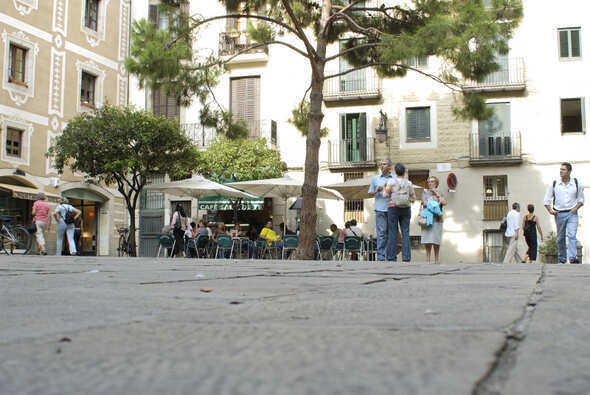
Plaça del Pi is a charming square in the Gothic quarter, dominated by the Santa Maria del Pi church and surrounded by galleries and cafés.
Plaça del Pi is one of the most pleasant squares in Barcelona. Its name means “pine tree square” — and indeed, a pine tree still stands there. Admire the portal of the Santa Maria del Pi Church, crowned by a rose window that is said to be one of the largest in the world after Notre Dame in Paris. Street performances, musicians, and cafés bring this square to life both in winter and summer.
Address: Plaça del Pi, 08002 Barcelona, Spain
Plaça Reial

Plaça Reial is an elegant, lively neoclassical square, famous for its arcades, palm trees, restaurants and lampposts designed by Gaudí.
Located just off La Rambla, near the port, Plaça Reial is one of the most iconic and lively squares in Barcelona. With its elegant arcades, neoclassical façades, and majestic palm trees, it exudes a refined Mediterranean atmosphere.
Created in the 19th century, the square was intended to honor King Ferdinand VII. At its center stands the emblematic fountain Font de les Tres Gràcies, surrounded by lampposts designed by a young Antoni Gaudí — one of his earliest works for the city.
Today, Plaça Reial is a popular meeting point where cafés, restaurants, and tapas bars attract both locals and visitors, day and night. Its vibrant ambiance, especially thanks to street performers and nightlife, makes it a must-see stop when visiting Barcelona.
The Jewish Quarter of Barcelona

Barcelona's Jewish quarter, known as El Call, is a maze of narrow streets steeped in history, a vibrant testament to the city's medieval Jewish community.
The Jewish Quarter of Barcelona, known as the Call, is one of the oldest and most fascinating parts of the Gothic Quarter. A testament to the Jewish presence in Catalonia since the Middle Ages, it is characterized by a maze of narrow, picturesque alleys that still bear the imprint of this once-thriving community until their expulsion in 1391.
Among its most iconic sites is the Sinagoga Major, one of the oldest synagogues in Europe, reflecting the Call’s rich cultural and spiritual heritage. As you stroll through the streets, you can still spot Hebrew inscriptions carved in stone and feel the history that lingers in the walls.
Today, the area blends ancient remains with a bohemian atmosphere, featuring small artisan shops and art galleries. A walk through the Call is an immersion into a lesser-known chapter of Barcelona’s history, where every stone seems to whisper memories of a bygone era.
Las Ramblas
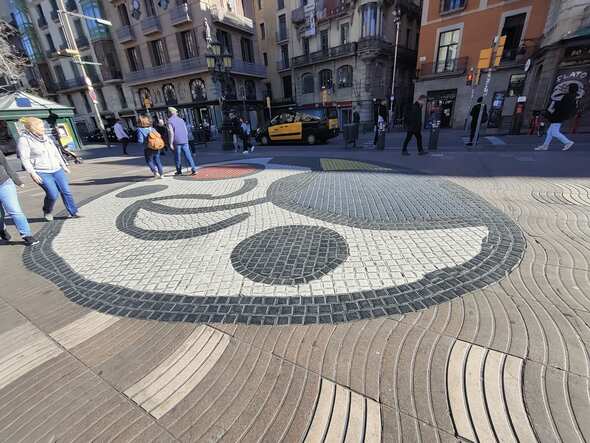
The Joan Miró monument on the Ramblas is a colourful mosaic embedded in the ground, a joyful nod from the artist to his native city.
And to end your walk, head to Las Ramblas, the famous plane tree-lined avenue that marks the western boundary of the Gothic Quarter. A place full of life and performances, it carries the neighborhood’s vibrant energy all the way to the port, adding a final lively touch to your visit.
Tip: For an even more magical experience, stroll through the quarter at dusk, when the lanterns illuminate the Gothic façades and the atmosphere turns almost enchanting.